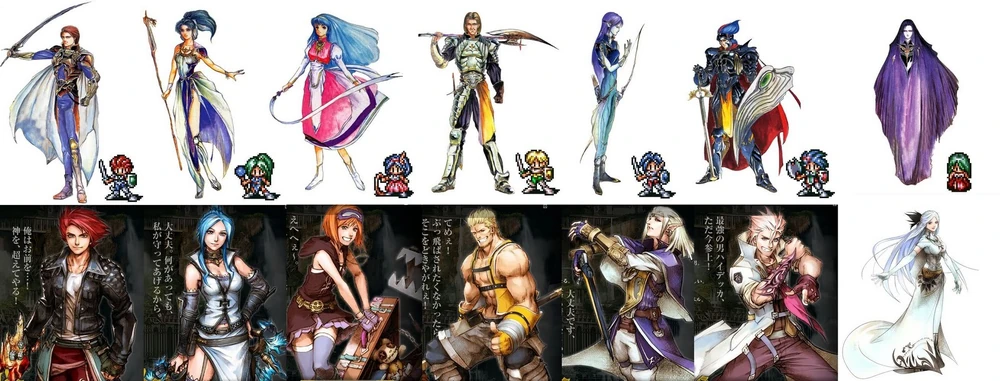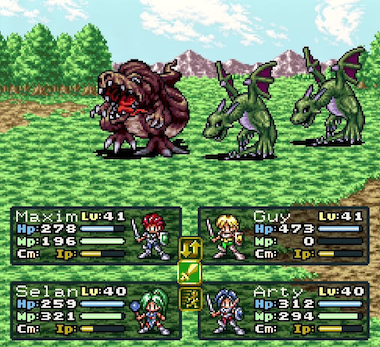Lufia’s Return A turn for the good... or the bad?
Originally published Jan. 16, 2011
 Growing up during the heyday of the original Nintendo and Super Nintendo consoles, I missed out on some remarkable RPGs that graced both platforms.
Growing up during the heyday of the original Nintendo and Super Nintendo consoles, I missed out on some remarkable RPGs that graced both platforms.
However, my chance to immerse myself in these RPGs finally arrived during my high school years, offering me the chance to experience the titles I had missed out on as a child. One such game was Lufia 2: Rise of the Sinistrals.
What truly intrigued me about Lufia 2 was its role as a prequel to the first game. This aspect held special significance, stemming from the fact that the basis of the story was rooted in the dramatic prologue of
its forerunner, Lufia and The Fortress of Doom.  This prologue depicted the heroic cast taking on the ultimate antagonist. Lufia 2 creatively expanded upon this starting point, drawing from the prologue’s events which are set 90 years prior to Lufia and The Fortress of Doom.
This prologue depicted the heroic cast taking on the ultimate antagonist. Lufia 2 creatively expanded upon this starting point, drawing from the prologue’s events which are set 90 years prior to Lufia and The Fortress of Doom.
This gap allowed the game to cultivate its own narrative while honoring the integrity of the original’s storyline. This achievement stands as an interesting endeavor, as other prequels to franchises usually encounter difficulties in maintaining the integrity of the original title.
Imagine my surprise when a Lufia 2 re-make was announced in 2009 for the Nintendo DS.
The news filled me with sheer excitement, as it signalled a reimagining of the original game, reminiscent of the approach taken with Final Fantasy III and IV for the DS.
The main characters, in particular, had undergone remarkable transformations, shedding their conventional fantasy RPG appearance in favor of a contemporary aesthetic reminiscent of Cloud Strife from Final Fantasy VII.

In the case of the hero, Maxim, his cape and armor were replaced with a leather jacket and red pants. Even the main love interest, Selan, underwent a transformation from a character resembling a traditional image to a more warrior-like appearance.
The new character designs didn’t particularly disturb me, but when I finally played the game, it turned out to be quite different from my expectations. The original game, featuring a classic turn-based battle system reminiscent of Dragon Quest or Phantasy Star, had been replaced with an action-based one. This change itself wasn’t too bad, considering my enjoyment of action-based battle systems like Star Ocean: The Last Hope, however, the issue arose from the limitation of controlling only one character on-screen at a time, which posed a challenge.

Initially, I assumed that the limitation stemmed from the fact that my party consisted of only 1 or 2 characters. However, as I delved further into the game, I realized that even with a 4-member party, the gameplay still focused on utilizing only one character for both battling and navigating the puzzles within the game.
I find myself genuinely questioning the rationale behind the development team’s decision to implement this approach, especially considering the context of a game which previously emphasized the multi-character party.
It feels as though it would have been a better to maintain and improve upon the original game’s turn-based system while adopting an action-based mechanism for exploring the expansive game world. This alternative might have proven more popular with older fans of the franchise such as myself when playing this remake.

There were a few other additions to this re-make that I found interesting, such as the addition of a a grid-like board for adding bonuses to your characters, such as Strength + 10 for example, making use of your different characters to explore an area, losing HP if you fall off a ledge, and the ability to reset your exploration and escaping a dungeon. The later additions I found to be odd as most RPGs wouldn’t be as forgiving as allowing you to reset your current exploration of dungeon or escaping a dungeon without using an item or magic spell.
I am at least glad that despite the change of battle systems that Lufia’s Ancient Cave, the 99-level randomly generated dungeon made famous by the original Lufia 2, is still present in the re-make and that the story of Lufia 2 remains relatively intact. I still hold out that things might change as I progress further in the game, but I don’t think I should get my hopes too high up. It just seems a little disappointing that when a game you liked from your youth is re-made, they somehow manage to ruin parts of the game that made it good.
Rating:



